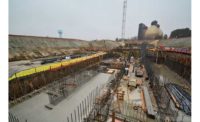Regional contractors are poised for healthy growth in the years to come, with many firms projecting consistent construction demand following a steady performance in 2015 and the first half of 2016.
The top 100 firms in this year’s ENR Texas & Louisiana’s Top Contractors ranking reported combined 2015 revenue of nearly $35.6 billion across the two states, with roughly $30 billion of that in Texas and $5.6 billion in Louisiana. The total was almost $1.5 billion more than the $34.16 billion reported in 2014.
“Clearly, what affects energy pricing affects our market,” says Stephen Toups, senior corporate vice president at Turner Industries. “When oil prices are down, our refinery customers reduce spending. But at the same time, when natural gas prices are low, our petrochemical clients’ economies are improved.”
The fluctuating energy sector continues to affect regional construction in 2016, “which is to say that the big construction surge we talked about in 2014 has spread out more evenly due to delays or cancellations of projects,” Toups adds. “Consequently, the predicted craft shortages have been eased for the time being.”
Texas markets in particular continue to grow despite the oil downturn, says Ray Sedey, Texas region president at McCarthy Building Cos. “It’s a great time to be building in Texas. There are some things that are slowing down on some of the developer work in North Texas, but in general, all market sectors are really going strong,” he says.
|
Texas & Louisiana 2016 Top Contractors |
Organic Growth
Ranking first for the fifth year in a row was Baton Rouge-based Turner Industries, which recorded nearly a $236-million increase in 2015 to reach a regional revenue total of $2.6 billion.
“In 2015, we were fortunate to see some significant organic growth by introducing a number of our specialty services into maintenance and construction sites where we work, as well as being awarded work by existing clients at sites of theirs where we were not previously working,” Toups says.
The growth was also made possible by several new projects coming on line, he adds.
Additionally, “2015 was a banner safety year for Turner Industries. Employees worked a record 45,031,094 hours at a record low 0.21 total recordable incident rate [TRIR], and 93% of our jobsites were recordable free,” Toups says.
Ranked fourth this year was Balfour Beatty Construction, which posted revenue of $1.39 billion for 2015, an increase of $281 million over the prior year.
“Pure market dynamics is one reason” for this growth, says Eric Krueger, senior vice president of the firm’s Texas division. “We’ve been able to grow based on our position as a leading contractor of choice for commercial projects that are related to corporate expansions or relocations to Texas.”
The company’s diverse portfolio also helps mitigate upswings and downturns in the market, Krueger notes.
“In the past year, we have moved resources from the wood-frame multifamily sector to meet the increase in opportunities across our commercial, education, interiors, municipal, hospitality and health care markets,” he says.
Meanwhile, Ferrovial US Construction Corp. recorded nearly a $300-million decrease in revenue in 2015 over the previous year, dropping three spots to sixth, with regional revenue of $1.14 billion.
“Over the last 24 months, we completed two projects totaling $3.5 billion ahead of their original construction schedules,” explains Daniel Filer, vice president business development at Ferrovial. “Replacing that level of revenue is difficult. We have been successful in winning new projects, but multibillion-dollar projects are rare. We are more focused on projects where we can bring value rather than just gobbling up backlog. Fortunately, we are in a position to take such an approach.” The firm completed the $2.7-billion, 13-mile LBJ Express project in Dallas three months ahead of schedule and on budget in September.
At 15th for the second year in a row was McCarthy Building Cos., which reported $580 million in regional revenue. “In Texas, year over year it has been pretty steady. What we’re seeing in 2016 is an uptick in all of our businesses,” Sedey says. “We have some community-based businesses in Dallas and Houston, and we also have a civil business that does work throughout the state both in heavy civil, working for TxDOT, to our marine business, where we’re doing work for folks like the Port of Houston. We see all of those markets and business sectors trending up year over year.”
McCarthy was recently awarded the $450-million Museum of Fine Arts Houston campus redevelopment. The firm also broke ground on a flight training center for Southwest Airlines at Love Field, is completing the realignment of S.H. 71 in Austin and has picked up a number of projects with the Port of Houston.
“I think 2015 was good over 2014; it was a little bit steady, but as I see 2016 and beyond, it’s looking good,” Sedey says. “I think we’ve had a little bit of restructuring that has just kind of solidified where people need to be and what business [is needed] to help not only manage the work that we have but also take advantage of the growth potential within the marketplace for this year and the years to come.”
Looking Ahead
Barring any major economic events in the next year—the U.S. presidential election and geopolitical events are creating some market anxiety—most contractors are not anticipating major changes in their markets.
“After 2017, we see a slowdown in the market, but not a major downturn,” Krueger says. “The markets in North and Central Texas are robust today and will remain so through 2016-2017, particularly the commercial, education, interiors, municipal, hospitality and health care sectors. In Houston, the market has changed dramatically—corporate expansion and relocation have declined as a result of the contraction of the energy market. However, the social infrastructure sectors—education, municipal, hospitality and health care—continue to grow to meet the demands of the recent population growth in Houston as well as in North and Central Texas.”
In Louisiana, Filer hopes to see more highway and other infrastructure improvements funded after a decade focused on flood-control projects. “As oil prices rebound, Texas and Louisiana will need to have the infrastructure in place to capitalize on the processing and export of domestic oil and natural gas,” he says.
Meanwhile, Toups says he hopes that the energy market and the political climate will stabilize so “we can all have some predictability in what the future business environment will hold.”







Post a comment to this article
Report Abusive Comment